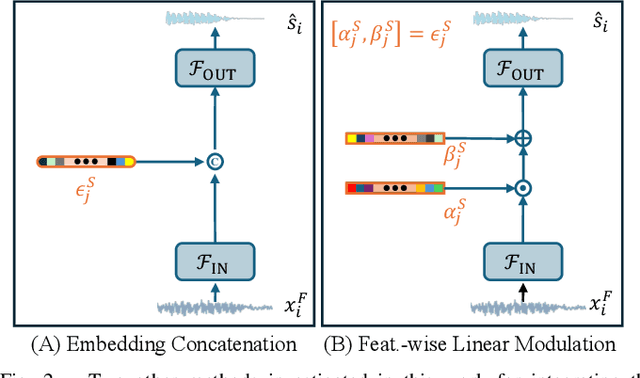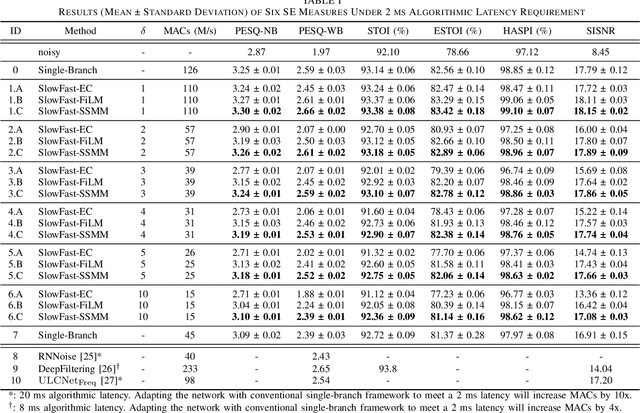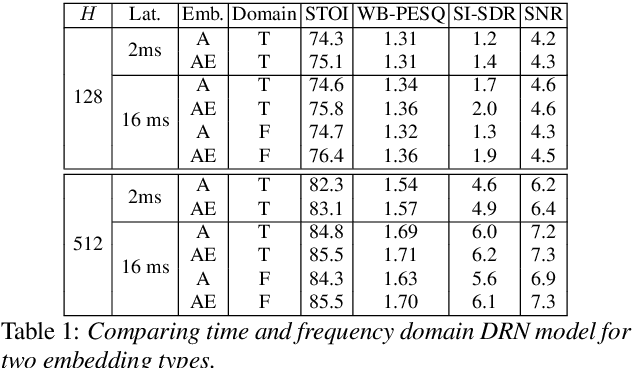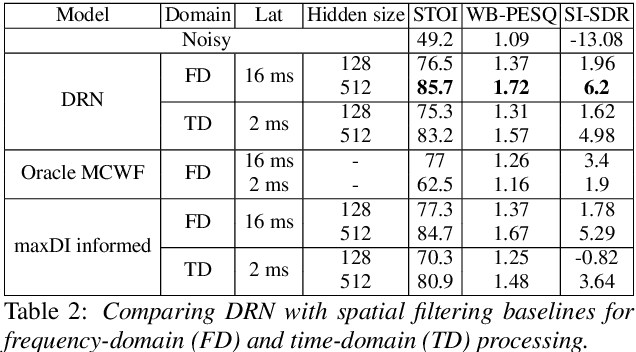Buye Xu
Improving Resource-Efficient Speech Enhancement via Neural Differentiable DSP Vocoder Refinement
Aug 20, 2025Abstract:Deploying speech enhancement (SE) systems in wearable devices, such as smart glasses, is challenging due to the limited computational resources on the device. Although deep learning methods have achieved high-quality results, their computational cost limits their feasibility on embedded platforms. This work presents an efficient end-to-end SE framework that leverages a Differentiable Digital Signal Processing (DDSP) vocoder for high-quality speech synthesis. First, a compact neural network predicts enhanced acoustic features from noisy speech: spectral envelope, fundamental frequency (F0), and periodicity. These features are fed into the DDSP vocoder to synthesize the enhanced waveform. The system is trained end-to-end with STFT and adversarial losses, enabling direct optimization at the feature and waveform levels. Experimental results show that our method improves intelligibility and quality by 4% (STOI) and 19% (DNSMOS) over strong baselines without significantly increasing computation, making it well-suited for real-time applications.
A Novel Deep Learning Framework for Efficient Multichannel Acoustic Feedback Control
May 21, 2025Abstract:This study presents a deep-learning framework for controlling multichannel acoustic feedback in audio devices. Traditional digital signal processing methods struggle with convergence when dealing with highly correlated noise such as feedback. We introduce a Convolutional Recurrent Network that efficiently combines spatial and temporal processing, significantly enhancing speech enhancement capabilities with lower computational demands. Our approach utilizes three training methods: In-a-Loop Training, Teacher Forcing, and a Hybrid strategy with a Multichannel Wiener Filter, optimizing performance in complex acoustic environments. This scalable framework offers a robust solution for real-world applications, making significant advances in Acoustic Feedback Control technology.
Efficient Audiovisual Speech Processing via MUTUD: Multimodal Training and Unimodal Deployment
Jan 30, 2025



Abstract:Building reliable speech systems often requires combining multiple modalities, like audio and visual cues. While such multimodal solutions frequently lead to improvements in performance and may even be critical in certain cases, they come with several constraints such as increased sensory requirements, computational cost, and modality synchronization, to mention a few. These challenges constrain the direct uses of these multimodal solutions in real-world applications. In this work, we develop approaches where the learning happens with all available modalities but the deployment or inference is done with just one or reduced modalities. To do so, we propose a Multimodal Training and Unimodal Deployment (MUTUD) framework which includes a Temporally Aligned Modality feature Estimation (TAME) module that can estimate information from missing modality using modalities present during inference. This innovative approach facilitates the integration of information across different modalities, enhancing the overall inference process by leveraging the strengths of each modality to compensate for the absence of certain modalities during inference. We apply MUTUD to various audiovisual speech tasks and show that it can reduce the performance gap between the multimodal and corresponding unimodal models to a considerable extent. MUTUD can achieve this while reducing the model size and compute compared to multimodal models, in some cases by almost 80%.
Modulating State Space Model with SlowFast Framework for Compute-Efficient Ultra Low-Latency Speech Enhancement
Nov 04, 2024



Abstract:Deep learning-based speech enhancement (SE) methods often face significant computational challenges when needing to meet low-latency requirements because of the increased number of frames to be processed. This paper introduces the SlowFast framework which aims to reduce computation costs specifically when low-latency enhancement is needed. The framework consists of a slow branch that analyzes the acoustic environment at a low frame rate, and a fast branch that performs SE in the time domain at the needed higher frame rate to match the required latency. Specifically, the fast branch employs a state space model where its state transition process is dynamically modulated by the slow branch. Experiments on a SE task with a 2 ms algorithmic latency requirement using the Voice Bank + Demand dataset show that our approach reduces computation cost by 70% compared to a baseline single-branch network with equivalent parameters, without compromising enhancement performance. Furthermore, by leveraging the SlowFast framework, we implemented a network that achieves an algorithmic latency of just 60 {\mu}s (one sample point at 16 kHz sample rate) with a computation cost of 100 M MACs/s, while scoring a PESQ-NB of 3.12 and SISNR of 16.62.
Dynamic Gated Recurrent Neural Network for Compute-efficient Speech Enhancement
Aug 22, 2024Abstract:This paper introduces a new Dynamic Gated Recurrent Neural Network (DG-RNN) for compute-efficient speech enhancement models running on resource-constrained hardware platforms. It leverages the slow evolution characteristic of RNN hidden states over steps, and updates only a selected set of neurons at each step by adding a newly proposed select gate to the RNN model. This select gate allows the computation cost of the conventional RNN to be reduced during network inference. As a realization of the DG-RNN, we further propose the Dynamic Gated Recurrent Unit (D-GRU) which does not require additional parameters. Test results obtained from several state-of-the-art compute-efficient RNN-based speech enhancement architectures using the DNS challenge dataset, show that the D-GRU based model variants maintain similar speech intelligibility and quality metrics comparable to the baseline GRU based models even with an average 50% reduction in GRU computes.
FoVNet: Configurable Field-of-View Speech Enhancement with Low Computation and Distortion for Smart Glasses
Aug 12, 2024


Abstract:This paper presents a novel multi-channel speech enhancement approach, FoVNet, that enables highly efficient speech enhancement within a configurable field of view (FoV) of a smart-glasses user without needing specific target-talker(s) directions. It advances over prior works by enhancing all speakers within any given FoV, with a hybrid signal processing and deep learning approach designed with high computational efficiency. The neural network component is designed with ultra-low computation (about 50 MMACS). A multi-channel Wiener filter and a post-processing module are further used to improve perceptual quality. We evaluate our algorithm with a microphone array on smart glasses, providing a configurable, efficient solution for augmented hearing on energy-constrained devices. FoVNet excels in both computational efficiency and speech quality across multiple scenarios, making it a promising solution for smart glasses applications.
All Neural Low-latency Directional Speech Extraction
Jul 05, 2024



Abstract:We introduce a novel all neural model for low-latency directional speech extraction. The model uses direction of arrival (DOA) embeddings from a predefined spatial grid, which are transformed and fused into a recurrent neural network based speech extraction model. This process enables the model to effectively extract speech from a specified DOA. Unlike previous methods that relied on hand-crafted directional features, the proposed model trains DOA embeddings from scratch using speech enhancement loss, making it suitable for low-latency scenarios. Additionally, it operates at a high frame rate, taking in DOA with each input frame, which brings in the capability of quickly adapting to changing scene in highly dynamic real-world scenarios. We provide extensive evaluation to demonstrate the model's efficacy in directional speech extraction, robustness to DOA mismatch, and its capability to quickly adapt to abrupt changes in DOA.
AV-CrossNet: an Audiovisual Complex Spectral Mapping Network for Speech Separation By Leveraging Narrow- and Cross-Band Modeling
Jun 17, 2024



Abstract:Adding visual cues to audio-based speech separation can improve separation performance. This paper introduces AV-CrossNet, an audiovisual (AV) system for speech enhancement, target speaker extraction, and multi-talker speaker separation. AV-CrossNet is extended from the CrossNet architecture, which is a recently proposed network that performs complex spectral mapping for speech separation by leveraging global attention and positional encoding. To effectively utilize visual cues, the proposed system incorporates pre-extracted visual embeddings and employs a visual encoder comprising temporal convolutional layers. Audio and visual features are fused in an early fusion layer before feeding to AV-CrossNet blocks. We evaluate AV-CrossNet on multiple datasets, including LRS, VoxCeleb, and COG-MHEAR challenge. Evaluation results demonstrate that AV-CrossNet advances the state-of-the-art performance in all audiovisual tasks, even on untrained and mismatched datasets.
A Closer Look at Wav2Vec2 Embeddings for On-Device Single-Channel Speech Enhancement
Mar 03, 2024



Abstract:Self-supervised learned models have been found to be very effective for certain speech tasks such as automatic speech recognition, speaker identification, keyword spotting and others. While the features are undeniably useful in speech recognition and associated tasks, their utility in speech enhancement systems is yet to be firmly established, and perhaps not properly understood. In this paper, we investigate the uses of SSL representations for single-channel speech enhancement in challenging conditions and find that they add very little value for the enhancement task. Our constraints are designed around on-device real-time speech enhancement -- model is causal, the compute footprint is small. Additionally, we focus on low SNR conditions where such models struggle to provide good enhancement. In order to systematically examine how SSL representations impact performance of such enhancement models, we propose a variety of techniques to utilize these embeddings which include different forms of knowledge-distillation and pre-training.
Decoupled Spatial and Temporal Processing for Resource Efficient Multichannel Speech Enhancement
Jan 15, 2024Abstract:We present a novel model designed for resource-efficient multichannel speech enhancement in the time domain, with a focus on low latency, lightweight, and low computational requirements. The proposed model incorporates explicit spatial and temporal processing within deep neural network (DNN) layers. Inspired by frequency-dependent multichannel filtering, our spatial filtering process applies multiple trainable filters to each hidden unit across the spatial dimension, resulting in a multichannel output. The temporal processing is applied over a single-channel output stream from the spatial processing using a Long Short-Term Memory (LSTM) network. The output from the temporal processing stage is then further integrated into the spatial dimension through elementwise multiplication. This explicit separation of spatial and temporal processing results in a resource-efficient network design. Empirical findings from our experiments show that our proposed model significantly outperforms robust baseline models while demanding far fewer parameters and computations, while achieving an ultra-low algorithmic latency of just 2 milliseconds.
 Add to Chrome
Add to Chrome Add to Firefox
Add to Firefox Add to Edge
Add to Edge